Tackling Food Fraud: Solid-Phase Microextraction Using Multi-Step Enrichment to Enhance Aroma Profiling in Olive Oil
Multi-step enrichment (MSE) enhances the performance of headspace–solid-phase microextraction–trap (HS–SPME–trap). Using this method combined with gas chromatography–mass spectrometry (GC–MS), the aroma profile of olive oil was analyzed to identify volatile and semivolatile organic compounds (VOCs/SVOCs). The technique was used to distinguish between olive oil samples by identifying unique VOCs as authenticity markers.
Food crime is serious fraud and criminality in food supply chains can be seriously harmful to consumers, food businesses, and the wider food industry (1). Fraudulent acts include adulteration (including a foreign substance that is not on the product’s label to lower costs or fake a higher quality), substitution (replacing a food or ingredient with another substance that is similar but inferior), and misrepresentation (marketing or labelling a product to wrongly portray its quality, safety, origin, or freshness).
To aid the prevention of food fraud, volatile organic compounds (VOCs) from olive oil samples are being analyzed to build profiles that can be used to discriminate between different commercial classes of olive oil (2,3). The profiles will make it easier to identify inferior products, or cheap products being misrepresented as more expensive varieties.
It is hoped that the data will help the International Olive Council (IOC) (4) identify analytical criteria for detecting fraud and determining the quality of olive oils. Currently, the IOC uses a sensory (or panel) test to classify oils in which human evaluators record their sensory responses to products being tested. Although a panel can be repeatable, reproducibility among panels is more challenging. Support from a sensitive analytical method would be highly beneficial to avoid misclassification of products.
Solid-phase microextraction (SPME) is a solvent-free sample preparation technique in which samples are extracted by immersive or headspace (HS) sampling. SPME is used for a wide range of sample classes and applications, including foods and beverages, environmental, clinical, industrial, and defence. This is made possible by the availability of a variety of SPME fibre phases (including polydimethylsiloxane [PDMS], polyacrylate and multi-phase divinylbenzene/carboxen/polydimethylsiloxane [DVB/CAR/PDMS]), which allow analyte selectivity to be optimized. However, workflows for conventional (“direct”) SPME sometimes suffer from its limited sensitivity. This stems from the small volume of sorptive phase on the fibre (typically ~0.5 μL of PDMS), as well as from the relatively slow heating rate of commonly used gas chromatography (GC) injection ports, resulting in broad peaks.
The primary focus of this work was to assess the incremental gain in peak area, and therefore sensitivity, for a range of representative analytes in olive oils when using an automated sample extraction and enrichment platform. Linear retention index values were calculated to confirm peak identification with mass spectrometry (MS) results from the NIST17 database. A commonly used multi-phase fibre for edible oils (DVB/CAR/PDMS) was selected for extraction. A balance between extraction time and sensitivity (across the broad volatility range of compounds in the aroma profile) needed to be achieved. A single sample extraction was compared to cumulative threefold and sixfold extractions from the same vial using various incubation times. Furthermore, the advantage of using shorter extraction times for MSE compared to an equivalent single extraction time is shown, for example, 3 × 10 min (total extraction time 30 min) is compared to a single 30-min extraction time. The successful application of MSE to the distinction of extra virgin olive oil, virgin olive oil, and lampante olive oil has been extensively shown by research conducted by Purcaro et al. (2,3) and is presented here.
Experimental
Section A: An extra virgin olive oil (EVO) sample purchased from a supermarket was used for a comparative analysis of single and multi-step SPME–trap extraction and enrichment (Figure 1).
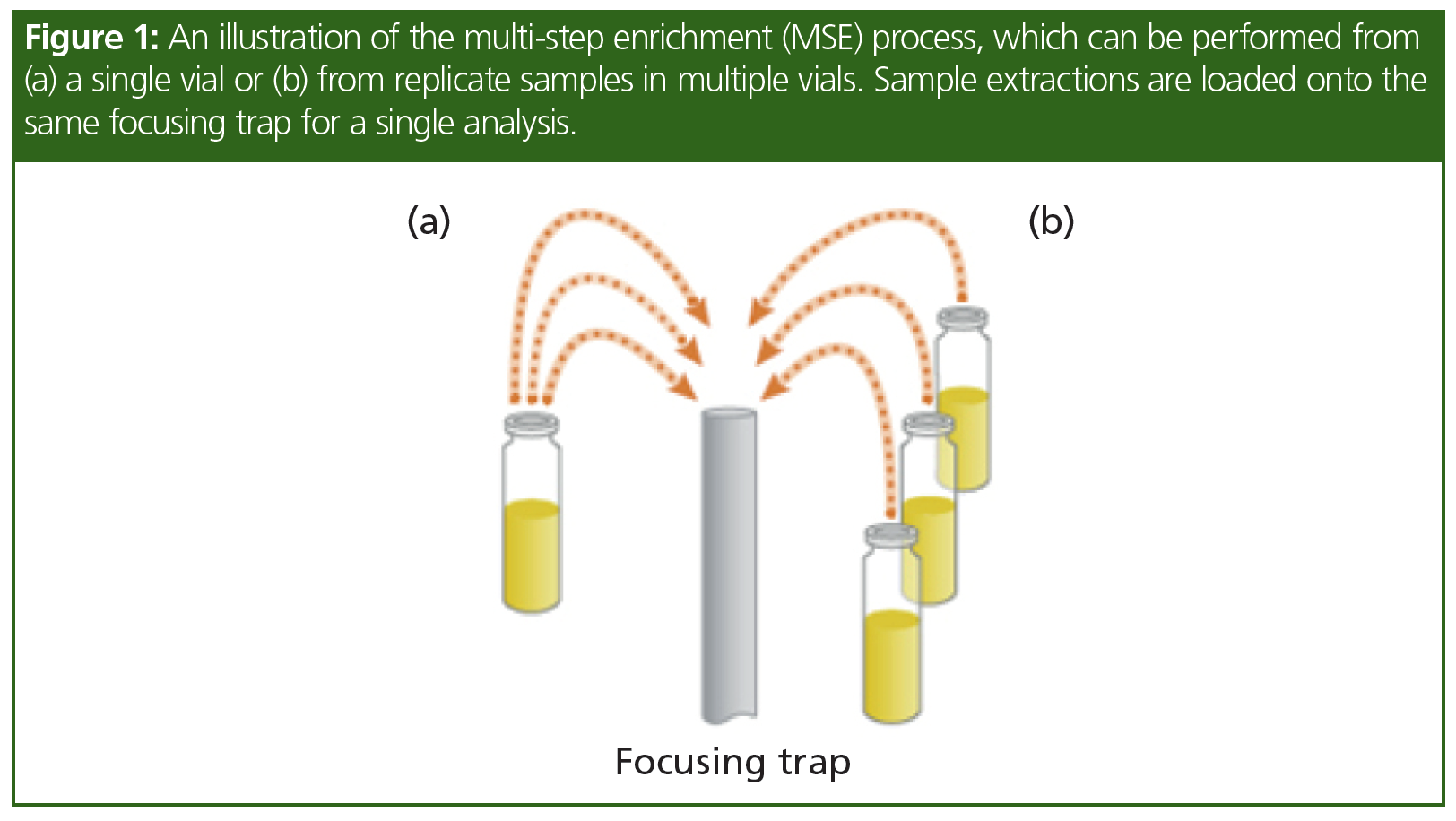
Section B: Five EVO, two virgin (VO), and four lampante (LO) olive oils were analyzed as part of a case study based on the MSE method developed in Section A.
Sample Preparation: Samples (1.5 g ± 0.05 g) were weighed into 20-mL screw‑top headspace vials, which were then sealed.
Extraction and Enrichment: Instrument: Centri (Markes International).
Headspace–SPME–Trap: Fibre: Multi‑phase DVB/CAR/PDMS, 10 mm, 50/30 μm df (MilliporeSigma), Sampling depth: 30 mm, Pre-sampling: 43 °C (5 min), Extraction: 43 °C (10 min or 30 min), Agitation: 300 rpm, Fibre desorption: 250 °C (2 min), Enrichment: 3 and 6 extractions (same vial), Enrichment delay: 5 min, Replicates: 3 for each cumulative analysis, Flow path: 180 °C, Focusing trap: “Material emissions” (part no. U-T12ME-2S), Purge flow: 50 mL/min (1 min), Trap low: 0 °C, Trap high: 300 °C (10 min), Split ratio: 5:1.
GC–MS: Column: SLB-5ms (silphenylene polymer), 30 m × 0.25 mm, 0.5-μm (MilliporeSigma), Oven program: 30 °C (5.5 min), 10 °C/min to 310 °C (0 min), Constant velocity: 35.9 cm/s (He),
Transfer line: 280 °C, Ion source: 200 °C, Mass range: m/z 50–450.
Data Analysis: Section A: ChromSpace (SepSolve Analytical). Section B: ChromCompare+ (SepSolve Analytical). MS library: NIST17 database. Experimental linear retention index within ±15 units.
Results and Discussion
Section A: Comparing the Sensitivities of Single Extraction and Multi-Step Enrichment: The EVO sample was extracted with a multi-phase porous fibre (DVB/CAR/PDMS). When using this fibre, short extraction times are recommended to reduce competitive adsorption between the VOCs (5). The EVO sample was extracted once, then three and six times from the same vial (allowing 10 min for each extraction) and injected each time onto the same focusing trap of the extraction and enrichment platform, such that the multiple extractions were then analyzed in a single GC–MS run. The focusing trap was maintained at a sub‑ambient temperature for all injections and then rapidly heated to release the compounds as a narrow band into the capillary column. Figure 2 shows a comparison between the three extraction modes (single extraction and the three and six extractions), which demonstrates an increase in abundance that is proportional to the number of extractions. The gain in sensitivity using MSE was evaluated by dividing the peak area of each compound by the results obtained after a single extraction. The overall extraction ratio showed an average 3.01- and 5.96-fold increase (for the three and six extractions, respectively) in abundance, indicating that the headspace is likely saturated for extraction and after subsequent equilibrations, it is quickly replenished, providing a linear cumulative increment in analyte response compared to the single extraction. A representative selection of 10 compounds is shown in Figure 3 and Table 1 to further highlight this.
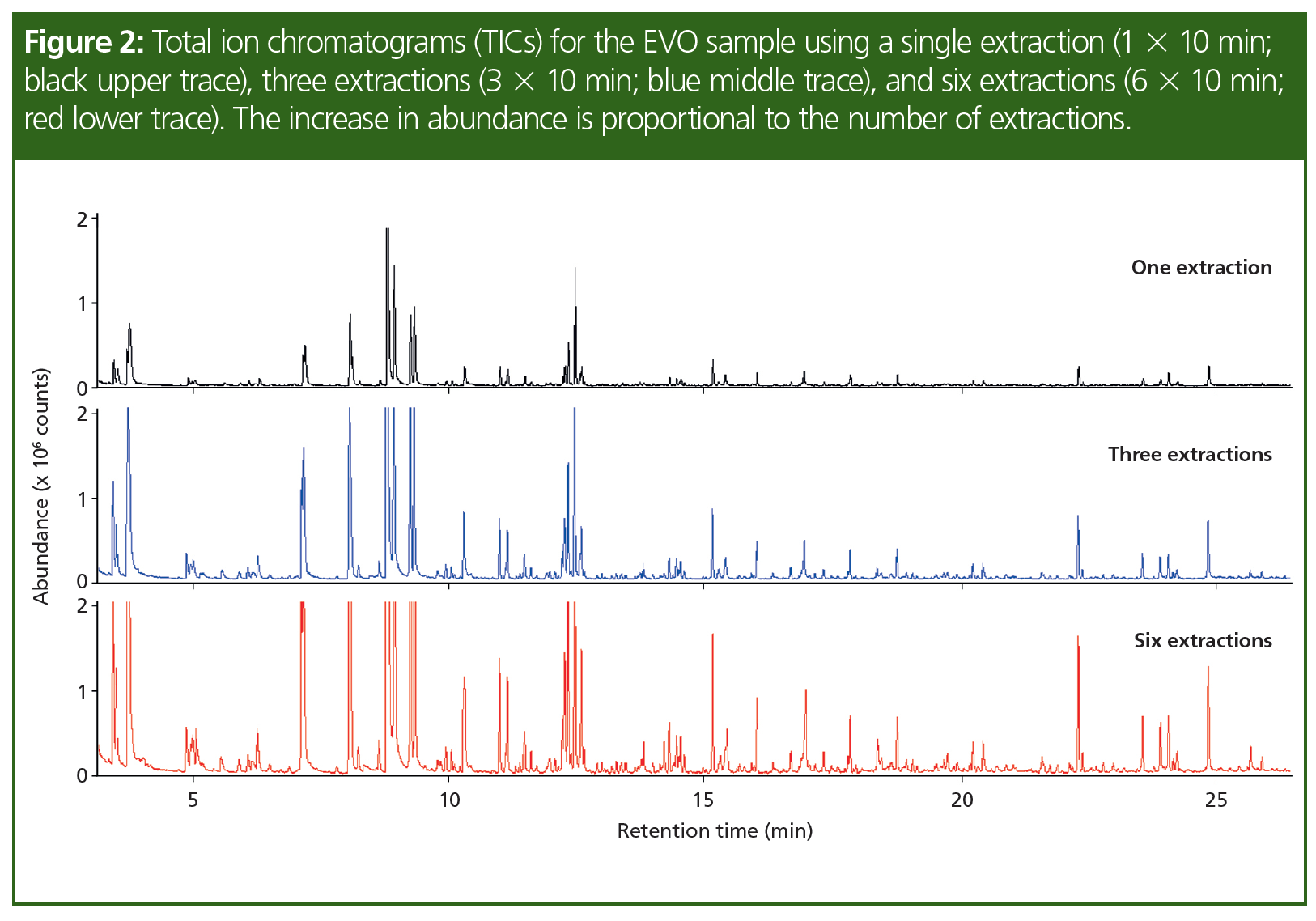
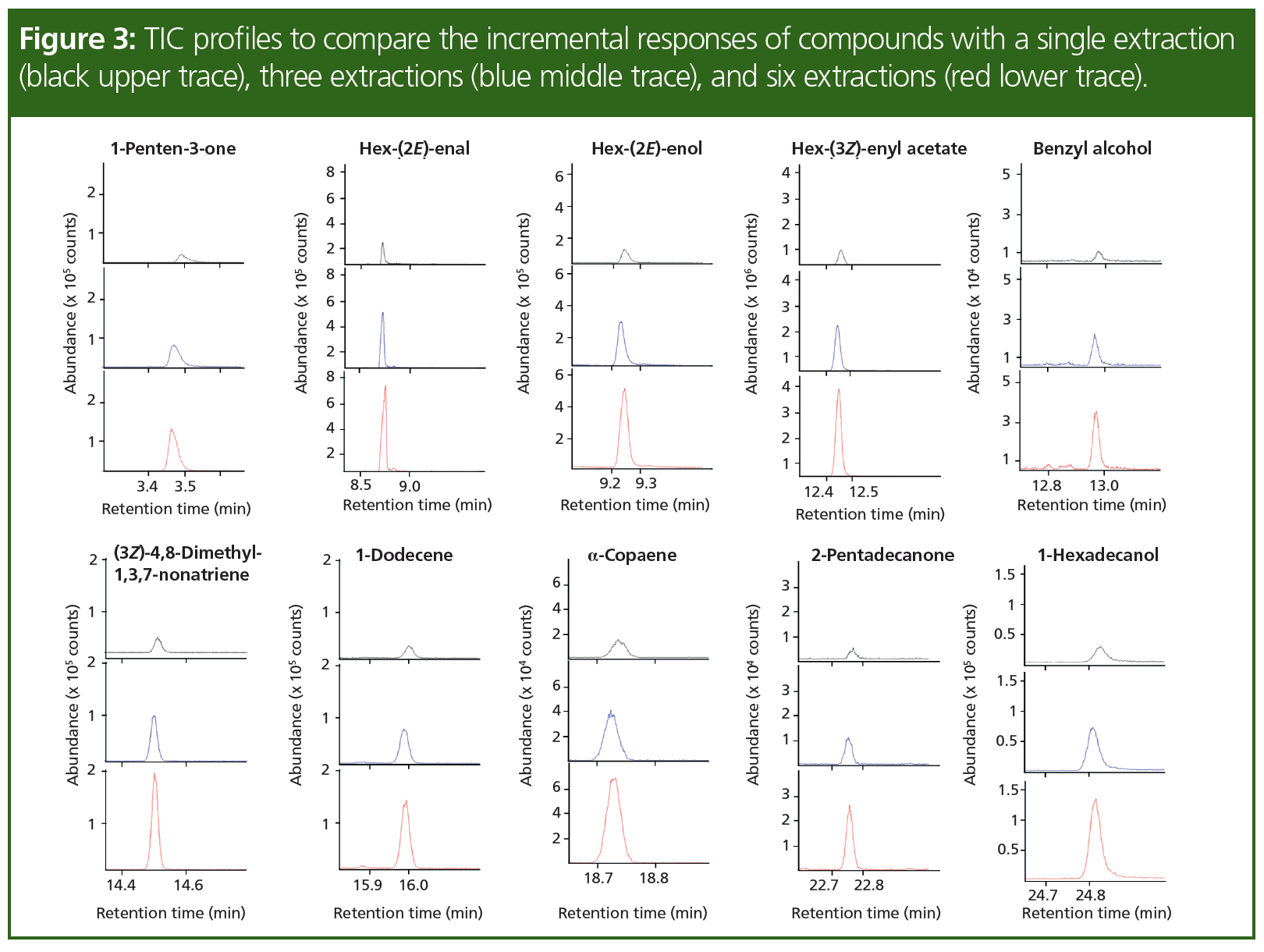
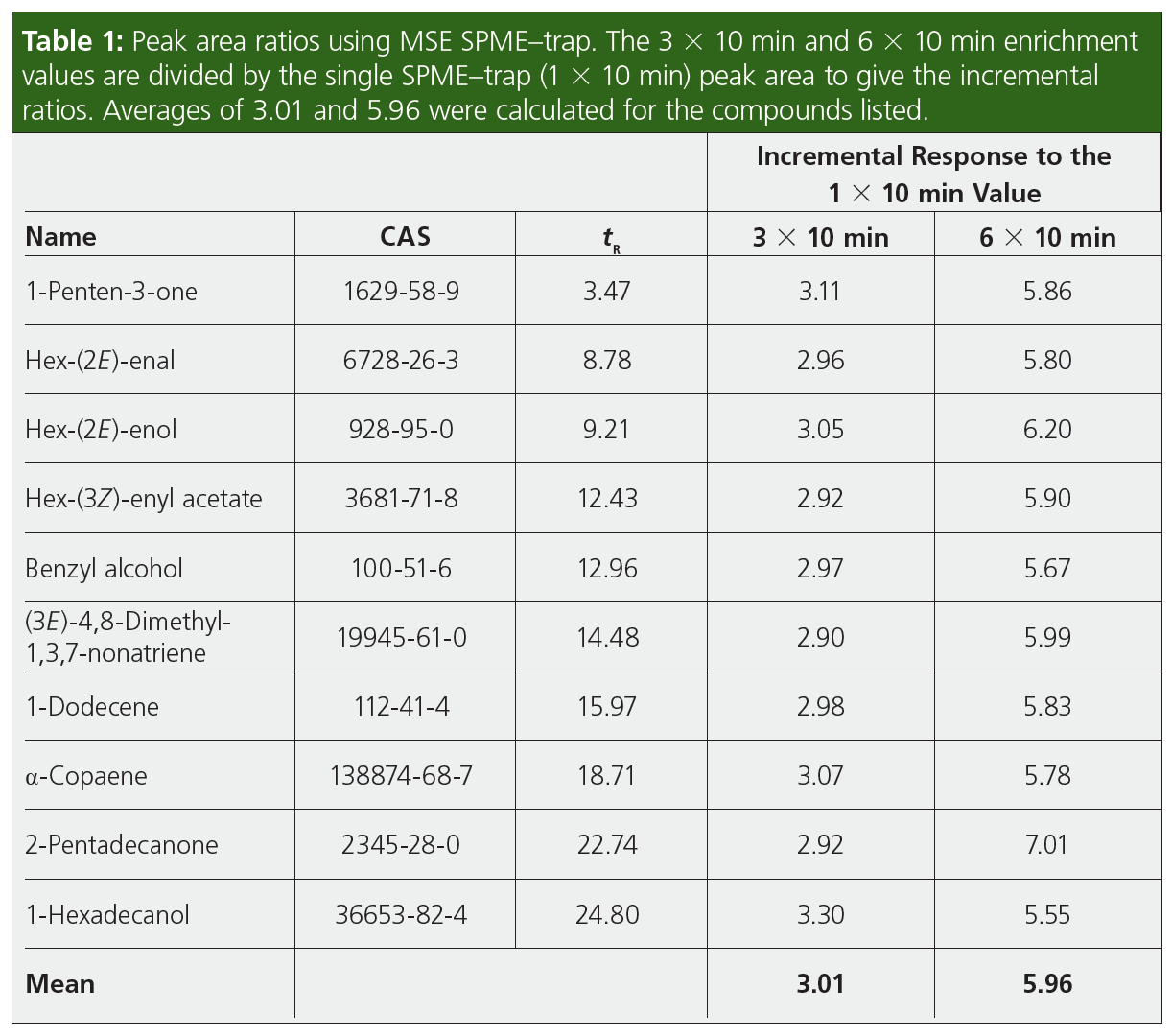
Comparison Between MSE and a Single Extraction Using the Same Total Sampling Time: When designing an analytical system, the sampling method is an important consideration because the characteristics of some compounds, such as polarity or volatility, can affect the profile of a sample. For example, when sampling with a SPME fibre, profiles are altered both by the selectivity of the coating itself and by competitive adsorption processes, which may be related to the time taken to extract samples. A longer extraction time facilitates this displacement effect, which can occur with some heavier analytes. To better understand the effect of sampling time, a comparison between one extraction for 30 min and three extractions for 10 min (to give the same total sampling time) was carried out. Figure 4 shows that the single extraction (1 × 30 min) did not necessarily provide better results than the shorter repeat extractions. Differences are more evident with the semivolatile organic compounds (SVOCs), for which, in some cases, a 10-min extraction provided a significantly higher yield (inset in Figure 4[a]). For 2-pentadecanone, dibutyl adipate, n-butylbenzenesulfonamide, and 1-hexadecanol, the abundances for the 3 × 10-min extractions are between four and six times higher than those of the 1 × 30-min extractions (Figure 4[b]). This suggests that short repeat samplings enable the detection of more compounds in the volatile profile of extra virgin olive oil than the single extraction. Dibutyl adipate and n-butylbenzenesulfonamide are plasticizers, likely to have leached from the oil’s packaging.
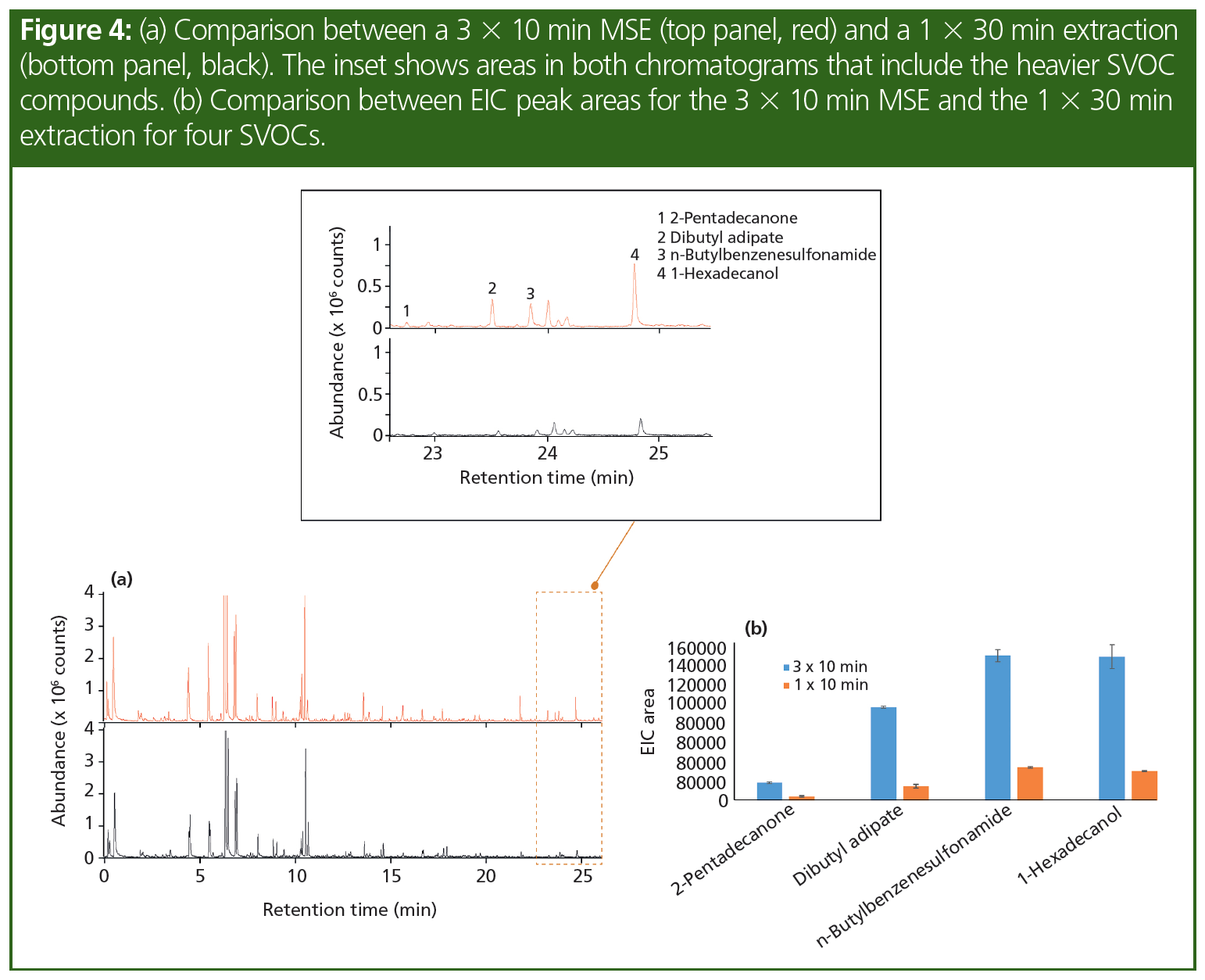
Section B: Identification of Specific VOC Markers from Different Olive Oils by Multi-Step Enrichment: There is an increasing interest in the use of VOCs as markers of authenticity in food matrices. Finding a reduced set of volatile markers offers a rapid and potentially inexpensive screening tool. Here, VOC profiles of several olive oils were automatically compared using the software platform. It identified a reduced set of VOCs with the potential to act as markers of quality to distinguish between olive oil samples.
Eleven samples of olive oils (five EVOs, two VOs, and four LOs) were analyzed. Six SPME–trap extractions were performed, each for 10 min, which avoided the competitive adsorption discussed earlier. See Purcaro et al. (2) for a statistical analysis of the results. A reduced set of VOCs can be used to distinguish between EVOs (red) and LOs (pink), while the VOs (blue) are at the median position between the two, as shown in the principal components analysis (PCA) score plot (Figure 5). The results correlate with the compositions of the oils: VOs present some compositional defects, but not as strongly as the LOs, and maintain important positive attributes contained in the EVOs.
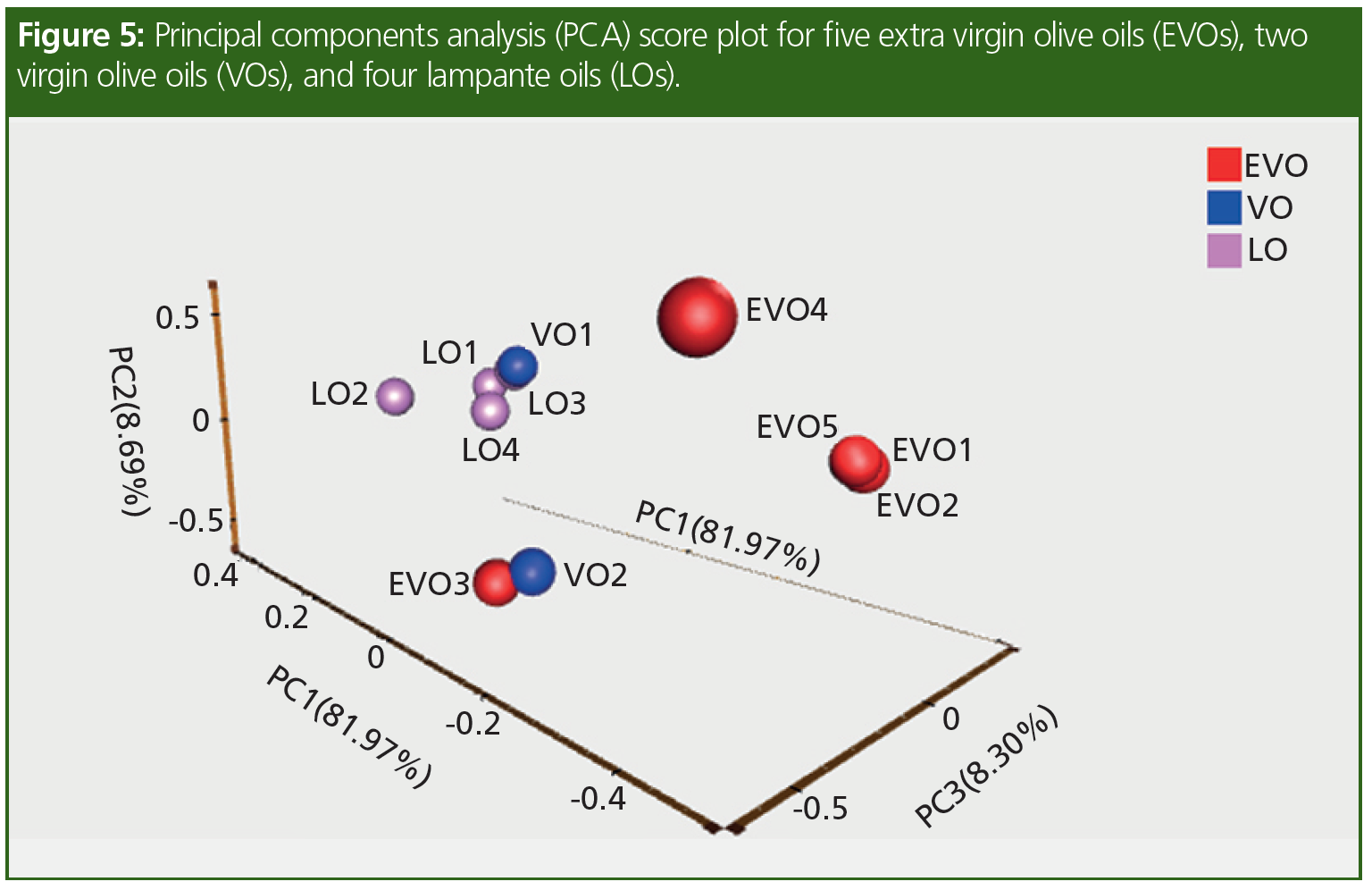
Interestingly, two of the four compounds in the reduced set of VOCs were not detected when a single extraction was performed (the late-eluting compounds cyclododecanol and octacosane), an observation that highlights another benefit of using MSE with SPME–trap.
Conclusions
This work was carried out to investigate the potential of SPME when combined with multi-step enrichment to provide an enhanced characterization of the aroma profiles of a range of olive oil samples. The results demonstrate that MSE SPME can improve the overall sensitivity for the VOCs and SVOCs in these products and enhance the understanding of information from cross‑sample studies. Using MSE SPME with shorter extraction times is preferable to an equivalent sampling time for a single extraction, both in terms of overall signal response and for limiting the competitive mechanisms that occur when adsorption fibres are used. This study suggests that a reduced number of VOCs could be used to distinguish expensive extra virgin olive oil from other types, so the technique could help confirm authenticity and prevent fraud.
References
- https://www.food.gov.uk/safety-hygiene/food-crime
- S. Mascrez and G. Purcaro, Journal of Separation Science 43, 1934–1941 (2020).
- S. Mascrez and G. Purcaro, Analytica Chimica Acta 1122, 89–96 (2020).
- https://www.internationaloliveoil.or
- T. Górecki, X. Yu and J. Pawliszyn, Analyst 124, 643–649 (1999).
Giorgia Purcaro has a Ph.D. in food science from the University of Udine, Italy. She spent part of her postdoc at the University of Messina in Italy, and at Dartmouth College in the USA, before being appointed as Analytical Chemistry Professor at the University of Liège, Belgium. Her main areas of research applications are related to contaminants analysis in food, mainly hydrocarbons (polycyclic aromatic hydrocarbons [PAHs] and mineral oils), and food quality, primarily the volatile profile, by using hyphenated chromatographic techniques such as liquid chromatography (LC)–GC(×GC) and GC×GC.
Rachael Szafnauer received an M.Sci. in forensic science from the University of South Wales, UK, where her final‑year project focused on fingerprinting emerging psychoactive substances using advanced techniques such as GC×GC–time-of-flight (TOF)‑MS, in collaboration with Markes International. She later took up the role of thermal desorption product specialist at Markes, providing technical and application support to the commercial team, before taking on her current role at the start of this year, specializing in the development of applications using extraction and enrichment techniques.
Elinor Hughes obtained her B.Sc. in chemistry and Ph.D. in organic chemistry at Bangor University, UK. After working for a chemical manufacturing company for three years, she moved to the Royal Society of Chemistry where she worked in journals publishing for six years and on Chemistry World magazine for four years. This was followed by five years as a freelance copyeditor and science writer. Her current role is technical copywriter at Markes International.
E-mail: enquiries@markes.com
Website: www.markes.com
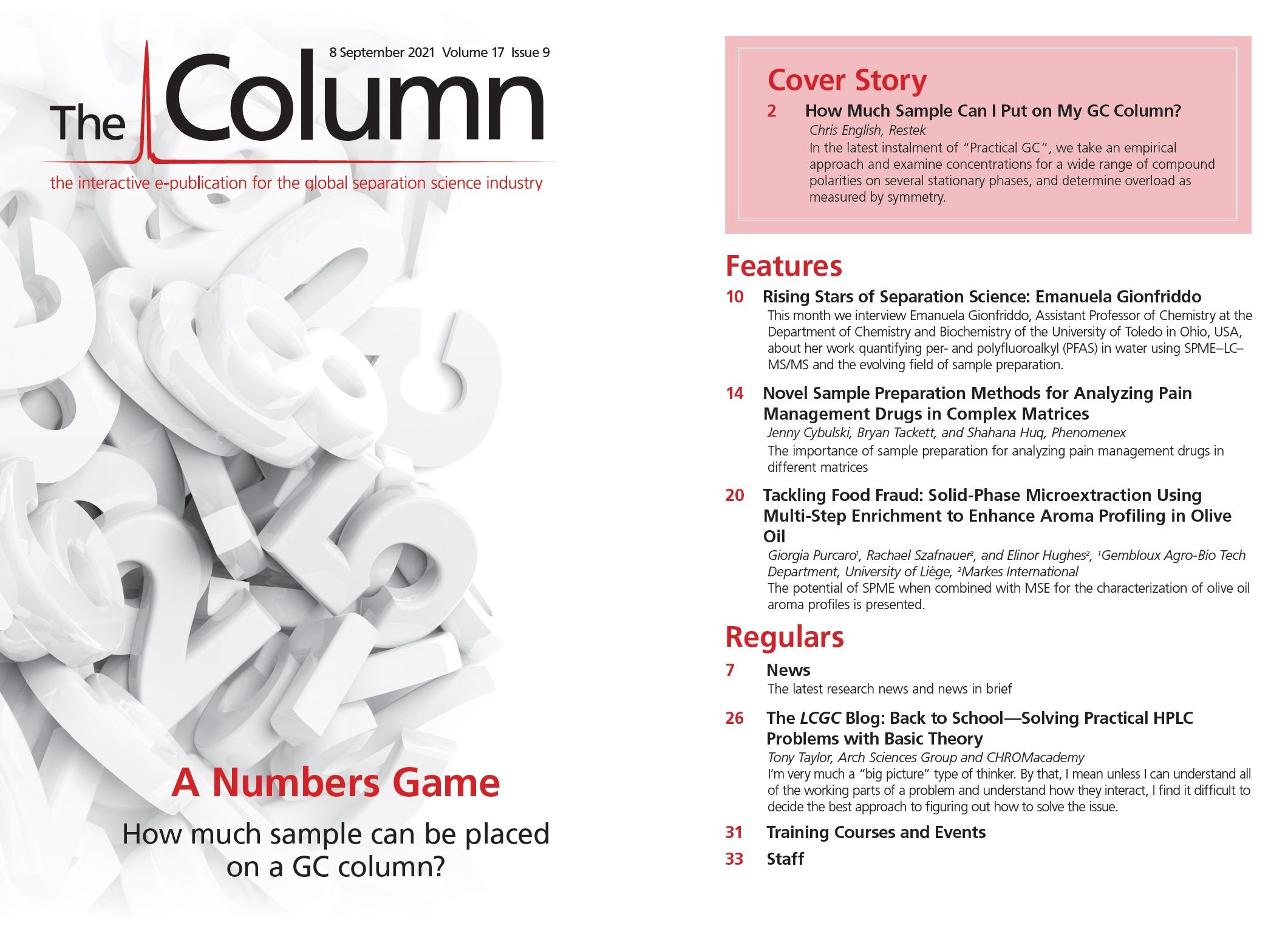
New Method Explored for the Detection of CECs in Crops Irrigated with Contaminated Water
April 30th 2025This new study presents a validated QuEChERS–LC-MS/MS method for detecting eight persistent, mobile, and toxic substances in escarole, tomatoes, and tomato leaves irrigated with contaminated water.

.png&w=3840&q=75)

.png&w=3840&q=75)



.png&w=3840&q=75)



.png&w=3840&q=75)














